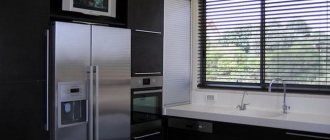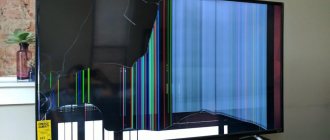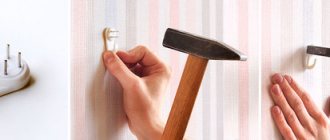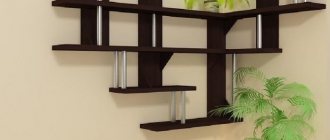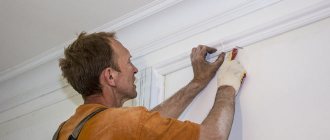SHARE ON SOCIAL NETWORKS
FacebookTwitterOkGoogle+PinterestVk
There are no strict rules that regulate at what height to hang a TV on the wall. However, there are generally useful recommendations from ophthalmologists and other experts that the user should keep in mind to ensure a comfortable and safe TV viewing experience. To install the TV correctly, it is necessary to take into account the purpose and dimensions of the room, the diagonal of the screen and the features of the situation in the room.
To hang the TV at the optimal height, it is recommended to follow certain recommendations
What factors influence the choice of the height of the TV on the wall?
There are several factors that influence the choice of location and height of the TV relative to the floor. The first of these is the size and purpose of the room. The interior design, selection and arrangement of furniture depend on these criteria. It is necessary that a paired socket for the device be located nearby, which should be located at a distance of no more than 45 cm from the bracket. This creates an aesthetically pleasing wall that is not cluttered with wires.
First of all, the height of the TV depends on the size of the device
The optimal location for installing the TV directly affects viewing comfort. To do this, it is recommended to take a comfortable position in the room and, based on your personal feelings, identify the wall where the device should hang.
According to the recommendations of experts, the TV should be located in a straight line between the viewing area and the wall where it is located. This space should not be overloaded with other interior elements, so as not to create some discomfort when watching TV.
The next important criterion is the screen size. The distance to the TV and the diagonal of the device are in a certain ratio. The larger the screen size, the further the unit should be located from the person’s seat and the higher it is in relation to the floor. The second factor is due to the fact that when the screen moves away, the viewing angle narrows significantly. This parameter is also influenced by the height of the armchair, sofa, chair or other piece of furniture from which viewing will be carried out.
Placement in the bedroom
Placing a TV in the bedroom depends on many important reasons. One of the main things is what kind of bed you have. If you close your eyes while lying on your low bed and relax for a while, then you can take the most comfortable position for you when watching programs.
By opening your eyes and mentally marking the place on the wall where your gaze falls, you will receive an answer at what height is best to hang the TV in the bedroom.
Most likely, it will be slightly higher than where the TV is installed in the living room, but you should remember the advice of doctors - do not exceed the angle of deviation from the center of the screen when viewing, which Ideally it should be no more than 30 degrees.
Otherwise, osteochondrosis of the cervical spine, which occurs due to incorrect head position and prolonged viewing of television, will soon make itself known.
To more accurately adjust the deflection angle, care should be taken to use high-quality mounts for brackets with a variable inclination angle for installing the TV on the wall. monitor plane.
It is advisable to use brackets that adjust the monitor position in two planes, not only in tilt, but also in rotating the screen left and right.
Before installing a TV in the bedroom, you need to find the place from which it is most likely to be viewed. For a lying position, you should choose a higher height: slightly higher than the usual direct gaze in a standing state.
The ideal option is still considered if the tilt angle during viewing changes no more than 30 degrees from the center of the screen.
As a way out, you can use a wall bracket. In this case, you can change the rotation of the TV at any time.
The bracket is attached as follows:
- The middle of the bracket is fixed at a level of 150 cm from the floor.
- Outlets for sockets and cables are mounted 25 cm above the bracket.
Methods for determining the distance to the TV screen from the viewing point
There are two ways to determine at what level to hang the TV. The first is based on personal feelings. To do this, you should take a comfortable position at the viewing point. Although a comfortable posture can be sitting, reclining or lying down, the screen should be at eye level of the person viewing it. You need to close your eyes for a few seconds. When they are opened instantly, the gaze will fall on a certain point on the wall. This area should become the center of the screen.
The first way to determine the height of the TV is related to your own viewing sensations
With this method, the rule of dependence of the size of the TV on the distance to it is not observed. Therefore, if you completely trust this option, with a high degree of probability we can say that your eyes will get tired when watching.
The second option involves a mathematical calculation. Expert recommendations are taken into account. The screen should be at eye level. If it is lower or higher, the image will be distorted. The optimal distance from the eyes to the TV screen is a value equal to the diagonal size multiplied by 3. For plasma, the screen dimensions are multiplied by 4.
If you choose a 3D or LED viewing technique, then the screen resolution is also taken into account, which affects the image quality and viewing comfort level.
For screens with a resolution of 720p, the recommended distance to the TV is calculated by multiplying the diagonal value by 2.3. For 1080p devices, which cause virtually no visual impairment or eye fatigue, the screen size is multiplied by a factor of 1.6.
The second method involves the use of mathematical calculations
Considering both methods, it should be concluded that the TV should be located at a distance of 1-1.3 m from the floor. If the device is hung lower, the likelihood of mechanical damage to the screen and friction of various objects against it, which may be in the hands of children playing or passing by, increases. passing adults. For short people, the lower limit of the limit is selected. For household members with a height of 160-185 m, you should choose a value of 1.1-1.15 m, and for taller people, the upper limit is selected.
Important! When choosing the height of the TV relative to the wall, you also need to take into account the height of the seating furniture.
Changing the position of the TV using the bracket
Bath installation height
To securely mount the plasma panel on the wall, you must purchase a bracket. The holes on the bracket and on the back of the TV must match each other. International standards, such as VESA, have been developed for this purpose. There are three main types of fastening devices.
Hard
This option is convenient for saving space, because the TV will fit snugly against the wall. Only small gaps remain for ventilation.
A clear fixation makes it impossible to change the position of the TV. Use a permanent installation only if you are sure that you will not want to change anything in the near future.
Inclined
The design with a vertical tilt angle of up to 20 degrees is also suitable for small spaces. Such fasteners are often used in the bedroom. The ability to tilt the TV can be useful when watching it from different positions: sitting or lying down, from the sofa, the floor, etc. When tilted, a gap of about 10 cm is formed between the wall and the top edge of the panel.
Turning
The universal mount allows you to both tilt the TV and rotate it to the sides. This option requires some space in the room, but at the same time it is very convenient. Considering the large number of moving elements, you should not skimp on quality. A heavy plasma panel located at a great distance from the wall puts a large load on the bracket.
Modern brackets are made in various designs and can themselves become an interior decoration.
The video explains how you can make your own bracket to hang your TV.
Useful recommendations from experts regarding the location of the TV
Thinking about what distance should be from the TV, most ophthalmologists came to a consensus. It is necessary that the device is at the optimal distance from eye level, which is calculated by multiplying the diagonal size by a factor equal to 2. The angle of deviation from the device should not exceed 30°. The optimal value is 15-20°. The lower this value, the better this arrangement is for the eyes. The minimum acceptable threshold is 10°. If it is lower, your eyes will be very strained when viewing the image.
To determine the optimal height of the device, ophthalmologists recommend multiplying the diagonal size by 2
The expanded viewing angle in width should not exceed 40°. Greater value is possible for myopic people. According to the recommendation of ophthalmologists, watching TV should be done in a sitting position with a straight back, which should be perpendicular to the floor, and the head may be slightly tilted forward. It is this position that minimizes the likelihood of developing myopia and scoliosis. The minimum safe distance from the floor to the TV must be at least 1 m.
Important! It is necessary that the middle of the TV screen is at eye level.
To install the TV on the wall, it is recommended to use inclined brackets. They will allow you to adjust the angle of the device while viewing and choose the most comfortable position for a particular situation. The mounting system must be designed strictly for the TV, as another option may not support the weight of the device. The brackets should be periodically tightened for more secure fixation.
Danger of incorrect installation
If the TV is installed incorrectly, the following difficulties may occur:
- higher than necessary – headaches and cramps are noted;
- below the required level – pain in the cervical spine and headaches;
- closer than necessary – deterioration of vision due to increased eye strain;
- further than necessary – uncomfortable viewing, inability to see details.
The distance from the viewer to the screen also matters. Distance L = k factor * diagonal size D. The k factor for Full HD TVs is 1.56. For example, with a diagonal of 42 inches (106.68 cm), the distance to the screen is 166.42 cm.
Mounting options for hanging TV
To securely place the plasma on the wall, it is important to choose the right quality fasteners. There are several options for TV brackets: rigid, inclined and universal. The first type of mount ensures that the TV is fixed in one position. The device will not be able to be rotated or bent. The TV is placed close to the wall, while ensuring a minimum ventilation gap.
For mounting TVs to the wall, inclined, rigid and universal brackets are used.
Important! When selecting a bracket with rigid fixation, there is no room for error in choosing the optimal height of the TV relative to the floor.
The tilt bracket allows you to tilt the TV vertically, while adjusting the viewing angle. This is very convenient when changing body posture while watching TV. Using the tilting bracket, you can choose a comfortable screen position when watching a program or movie while lying down, which is especially important if you place the TV in the bedroom. There will be a ventilation gap of 7-10 cm between the device and the wall.
The universal type of bracket is considered the most complex fastening option. Its special device allows you not only to tilt the TV horizontally, but also to rotate it to the right or left. This type of bracket is the most expensive in comparison with previous analogues.
Helpful advice! When the question arises of how to hang a TV in a corner, a universal bracket comes to the rescue.
Universal brackets are the most expensive, but at the same time the most optimal
The process of installing a TV on the wall is a fairly simple undertaking. To do this, you will need a hammer drill and the selected fastening element. Any model of bracket is equipped with the necessary set of fasteners to securely fix the device to the wall.
Types of fasteners
Before hanging your TV on the wall, you should consider all types of fasteners recommended by the manufacturer. In most cases, three types of brackets can be purchased for each model:
- hard;
- inclined;
- universal (turns sideways or up/down).
The latter are the most convenient and expensive; the first two types are purchased if you are absolutely sure that there will be no furniture rearrangements in the near future, and the planned position of the TV will be comfortable. A rigid mount implies a small gap for the ventilation holes of the device - about a few centimeters. The TV will be installed permanently, without the ability to adjust the viewing angle.
Rigid bracket
Tilt brackets are most often purchased for installing a TV in the bedroom. They will allow you to change the vertical position of the monitor, this is convenient if viewing is carried out from different points alternately: from behind a table, from a sofa or from the floor, as well as sitting or lying down. The distance from the wall to the panel will be about 10 cm.
TV Tilt Bracket
If you plan to hang the panel in the bedroom or living room, pay attention to the universal mount. The name speaks for itself; the user can set and change both the tilt angle and rotate the panel left or right. When choosing a bracket of this type, you should not save too much: the presence of a large number of moving parts requires excellent quality metal and bolts, since the weight of the TV will exert a constant load. Read more about different types of mounts in the article about choosing a bracket.
Universal TV bracket
How to determine a place to install a TV on the wall in the living room
The choice of height for placing the TV on the wall also depends on the purpose of the room. The device can be installed in any room. If it is the only one, it will most likely be placed in the living room. This is mainly the largest room in the apartment, where the whole family gathers to spend time together. Guests are received here and ceremonial feasts are organized. Deciding where and at what height to hang a TV in the living room should be based on ensuring maximum comfort for all family members when watching their favorite programs from different points in the room.
The installation location is determined based on the location of the furniture. The TV is most often installed on the wall, opposite which there is a soft corner, sofa or armchair. If there are several windows in the room, the TV is placed on a blank surface. If you hang it between window openings, it will cause inconvenience, as glare of light will be reflected in it.
Most often, I place the TV in the living room opposite the armchairs or sofa.
Do not place the TV near a fireplace or other heating devices. It should not be exposed to direct sunlight. It can become very hot, which will negatively affect its operation and reduce its service life. The distance from the fireplace to the TV should be at least 1.5 m. You can conduct an experiment and measure the temperature first near a cold fireplace, and then during its operation. At a distance where it has practically not changed, you can install equipment.
At what height to hang a TV in the living room: useful recommendations
To determine at what height from the floor to hang the TV in the living room, you should sit comfortably and look directly at the wall. The head should not be thrown back so as not to create stress on the cervical spine. The direction of the eyes will point to a point that should become the middle of the screen.
Important! The center of the TV screen or its upper third must be located opposite the person’s eyes.
The optimal distance to the TV from the floor for the living room is 1.4-1.6 m. The height of the upholstered furniture and the average height of family members are also taken into account. With a standard sofa height, the optimal screen level for children and adults will be different, so the average height of the TV is determined.
The TV in the living room is hung at a height corresponding to the eye level of a sitting person.
If you plan to watch TV from the sofa, you can position it slightly below the recommended level. If the hall is combined with a dining room, and watching programs is often done while sitting at a table, the unit can be hung a little higher.
Helpful advice! The larger the diagonal size of the TV, the lower it should be placed relative to the floor.
Many people install the TV in special furniture niches. However, this decision is not always correct. Here, the size of the screen and the height of the sofa from the floor are also taken into account. An imbalance may occur, causing discomfort while viewing.
To mount the TV in the living room, it is better to give preference to a universal bracket, thanks to which you can adjust the position of the screen both vertically and horizontally.
The average optimal height for a TV in the living room ranges from 140 to 160 cm
Installation tips from experts
As for hanging a TV receiver in a children's room or living room, where programs can be viewed from different angles, you can adjust the tilt, rotation and even height using appropriate brackets, which come in several types:
- inclined – adjustable vertically;
- tilt-rotary – changes position vertically and horizontally;
- fixed - is the most durable and cheapest option;
- movable – adjusts the location of the television receiver in space in almost any direction, including height;
- ceiling - attached to the ceiling.
The fastening process itself is not particularly difficult. You need to mark the holes on the wall with a pencil (taking into account the above recommendations), paying special attention to the horizontal level. Next, holes are drilled along the markings into which dowel screws are inserted, and one part of the bracket is attached to them. While the other is bolted to the television receiver. Then both components of the fastener are connected (the guides are inserted into the corresponding grooves).
Important! Even a slight misalignment of the bracket over time leads to the fall of the television panel. Therefore, you need to carefully mark the attachment points using a level.
But the success of the process of hanging a TV receiver largely depends on the material of the wall. So, experienced craftsmen give the following advice on this matter.
- When hanging on a plasterboard wall, it is necessary to cut exclusively into the metal frame of the partition using butterfly dowels.
- When mounting on a wooden wall, you should use several regular long self-tapping screws, and on a plywood wall, use butterfly dowels.
- To install the television receiver on a cinder block, plaster or wood concrete wall, the bracket is suspended using through fastenings using nuts, bolts and wide washers.
So, when hanging a television receiver from a wall, the height is selected, first of all, from the position of primary viewing of programs, which in turn depends on the purpose of the room. The method for calculating the distance from the floor was described in detail above. But you should remember to take precautions when mounting the TV so as not to injure your household and protect the equipment from falling.
At what height to hang a TV in the bedroom: room features
The location of the TV directly depends on the parameters of the bed, namely its height. To decide at what height to hang the TV in the bedroom, you need to take a comfortable position on the bed, close your eyes and relax for a while. When you open your eyes, you should intuitively mark a point on the wall, which should become the center of the device screen. The best option is to install the TV in the bedroom on the wall at a height of 1-1.5 m.
Helpful advice! The TV should be installed above the point of fixation of direct gaze in a standing position for a lying position.
In this case, the TV will be installed higher than in the living room. However, you should remember that you should not exceed the angle of deviation of the screen from the center when watching TV. The optimal value is 30°. Otherwise, problems will arise with the cervical spine, which will lead to osteochondrosis.
Related article:
How to hang a TV on the wall: tips for proper installation
Choosing the optimal location, height and location. Which bracket do you prefer? Advantages of wall mounting. Installation features.
The plane of the screen should be perpendicular to the line of sight. If a person watches TV in a lying position, with his head thrown back on the pillow, the monitor must be raised to the height of his gaze, while tilting the upper edge of the device away from the wall. In this case, the screen can be placed under the ceiling.
The height of the device in the bedroom depends on the position in which you plan to watch TV
In the bedroom, the TV can be attached to the ceiling. However, it does not have to be installed near the wall opposite the head of the bed. The device can be located directly above the bed. In this case, it is important to choose a reliable type of bracket.
The TV in the bedroom should be hung on an inclined bracket, which will allow you to adjust the angle of the screen in the vertical plane. You can choose a tilt-and-slide or tilt-and-swivel type of product. Its middle is attached at a distance of at least 160 cm from the floor. The question often arises at what height to make a TV outlet. On the wall, the outlets should be located above the bracket at a distance of 25 cm.
It should be remembered that LCD TVs are too sensitive to vertical tilts. If the monitor is positioned too low, the picture will be dark, while a high placement will result in a very light image.
Installation of mounting frames
We come to the most interesting section - the technical support for the entire event of placing the TV on the wall.
First of all, let’s make a reservation that the instructions that will be described below apply to the concrete walls of a permanent house, but we’ll also say a few words about wooden and plasterboard walls.
We need the following tools and equipment:
- Hammer.
- Drills for concrete, thickness 7-8 mm.
- Caps, screws.
- Bubble level.
- Drawing tools - ruler, square, pencil.
Marking
Important! As a rule, all consumables, except for the hammer drill, of course, are included with the mounting frame.
On the wall we select an area for installation; we will talk about specific height parameters in the next block. Using a square, we draw a right angle while maintaining straightness, which is checked with a bubble level.
It is necessary to “fit” one of the sides of the mounting frame into this drawn right angle, so that the frame itself will be installed without distortions. Otherwise, the TV will be tilted to one side.
Important! If the holes are drilled skewed, then it is unlikely that you will be able to install the TV level without drilling additional holes. In turn, the structure of the concrete will not allow drilling two holes at a close distance - a mowing area or hole may form.
The frame is “marked” with a pencil along special holes. Markings on the wall are additionally indicated by a level for straightness.
Drilling
You could write a whole treatise on drilling concrete, but we will briefly outline the main points.
To prevent the drill from starting to wander when drilling the surface, it is necessary to stick small pieces of cloth medical plaster on the area under the holes. It has a roughness that will prevent the drill from “running up” when rotating until it goes deep.
Please note: You only need to work with a hammer drill and concrete drills.
The following points must be taken into account, which can lead to serious problems:
- It is necessary to find out the passage of electrical cable lines so as not to drill them.
- If the drill hits the reinforcement, you should not continue drilling into concrete. It needs to be replaced with a cutter for working with metal.
The entire procedure is carried out at a confident pace without deviation of the drill along the angle. After the holes are made, the choppers are hammered into them.
Walls made of wood panels and plasterboard
Wooden oriented panels or MDF have sufficient load-bearing capacity, so fastening will not be difficult. The holes are drilled with a drill without the effect of a hammer drill. Next, everything is carried out similarly to the measures for concrete walls.
As for drywall, it can only accommodate small, lightweight television devices. The material is lightweight and not intended for heavy loads. The weight of TVs ranges from 5 to 20 kg. average.
Installation
It is produced by simply aligning the holes in the frame with the holes in the wall. Self-tapping screws are screwed into the holes.
This is important: But there is also one important nuance: touching the mounting frame and the concrete wall without maintaining a gap of 15-20 mm. undesirable. Since this will not allow you to use the cable panel on the back cover of the TV - the wall will prevent the connection of plugs and the power cable.
To maintain the gap between the frame and the wall, cylindrical bosses are provided.
Important! Therefore, it is necessary to take into account the length of the screws - at least 100 mm. Otherwise, the fastening will be unreliable.
At what height should you hang a TV on the wall in the kitchen?
TV in the kitchen is more often listened to while cooking than watched. When choosing its location in a room, you should take into account the area of the room and the distance of the device to the owners’ workplace. The placement of the monitor should not pose a danger to others, this is especially important if there are children in the house. The device can be installed on the bedside table, above the refrigerator and on the wall.
When placing the TV in the kitchen, take into account the size of the room and the distance to the viewing point
Helpful advice! The TV in the kitchen should not be placed near the sink, kitchen appliances, heating radiators or opposite windows.
When choosing at what height to hang a TV in the kitchen, you should proceed from whether the device will be placed at eye level of a person sitting at the table to ensure viewing while eating, or whether its central zone will be at eye level to someone standing. The optimal value can vary between 1-1.8 m.
In a small kitchen, it is better to place the TV as high as possible relative to the floor. The optimal distance from the floor to the TV on the wall is 1.75-1.8 m. The brackets must be fixed to the wall using metal anchors.
It is recommended to choose a tilt type mount that allows you to adjust the angle of the screen. It is better to give preference to models that have the ability to change the angle of rotation by 15-45°, horizontal or vertical movement by 5-50° and tilt by 15-30°. This is due to the fact that the TV in the kitchen is usually located at a height convenient for viewing while standing. When sitting, the image may be distorted. On LCD monitors the picture will be dark. An inclined type bracket can solve this problem.
If the TV is installed to view people sitting at a table, then it is necessary to take into account the location of the eye level
Important! In the kitchen, it is not recommended to install a TV in a furniture niche, which is due to the peculiarities of the microclimate in the room, which is characterized by high humidity and temperature changes.
Calculation of the correct position
It is for the sake of comfortable relaxation and watching TV shows that a TV is actually purchased, but for each room the height of its placement will be different. Why and at what height is it better to hang a TV receiver?
Watching programs in the kitchen soon turns into listening, so the height of the screen is not very critical, and in the kitchen the TV panel is hung higher than the calculated height, so that it does not interfere with work. Such fastening does not cause discomfort when watching programs.
To decide at what height to hang the TV in the living room, they start from maximum comfort when watching.
Medical studies have proven that the most optimal way is to mount the TV so that the distance from the bottom edge of the screen to the floor is 0.75-1 m.
Doctors also give practical advice on how to intuitively calculate the distance from the viewer to the TV screen. To do this, sit in the place from which you plan to watch TV, close your eyes, and after a minute open them. Where your gaze immediately fell, that place should be the middle of the screen.
At what height should you hang the TV on the wall in the bedroom? The recommended installation height of the panel will be slightly higher than in the hall or living room, and you can determine the placement point of the device in the same way as with the previous solution, i.e. just lying on the bed. The main rule when calculating the installation height of a television panel is your comfort when viewing.
In modern TV models, the picture does not flicker, and the screen does not emit electromagnetic waves, that is, it does not pose a danger to the eyes.
Therefore, you can watch a liquid crystal or plasma panel at any convenient distance, and installing a TV on the wall is possible in any case.
But the optimal ratio between the TV diagonal (the diagonal is the length between the upper and lower corners of the screen) and the distance from it to the viewers’ eyes still exists.
Features of installing a TV in a children's room
When choosing a place to install a TV in a children's room, you should focus on the age and height of the child. The position of the monitor should not create obstacles during the child’s active games. If the TV is hung too low on the wall, it may cause injury to the baby.
The child will watch cartoons from different positions, so the image on the screen must be of high quality both for a child lying down and for a child sitting on a bed or chair. Here you should take into account the characteristics of the child’s postures. An important factor is the location of furniture and toys. The optimal height is considered to be 1.2 m. The normal distance to the TV from the sofa or bed for a baby is considered to be 2-2.5 m.
When installing a TV in a nursery, you need to take into account that the child will watch it in different positions
A prerequisite for a child’s room is to mount the device using a universal bracket, which allows you to adjust the position of the screen depending on the child’s location and position. This will make it possible to ensure not only comfortable but also safe viewing of TV, eliminating strain on the eyes and spine.
A good solution would be to place the TV on the wall in the corner. Sockets should be placed as high as possible so that a child cannot reach the wires and antenna cable.
How to hang a panel yourself
Manufacturers of television monitors recommend contacting specialists to install the device. But it is possible to do this without outside help, provided that the TV screen weighs no more than 25 kg.
Basic installation rules
First you need to consider 3 main rules:
- Make sure that the wall on which the TV screen will be installed can support it. A device weighing more than 30 kg will not be suitable for a thin plasterboard wall. Hemming a thick plywood sheet will help to strengthen such a wall. A plasterboard ledge can be built on top to prevent the support from collapsing.
- Ensure free air circulation through the ventilation openings in the equipment. This condition does not allow installing a TV screen in a niche due to possible overheating and failure of the device. But if you still cannot avoid such installation, you should think about it in advance. Make a niche larger than the device itself so that there are gaps on all sides. And for the tightest niches, specially designed LSD panels are suitable.
- When installing the plasma on a movable bracket, tension in the power cable is eliminated. When purchasing the TV itself, it won’t hurt to immediately stock up on this holder. There are many variations of brackets, so choosing the right one will not be a problem.
How to choose a bracket
Depending on the degree of mobility, the following options are distinguished:
- with rigid fixation or fixed (for large TV screens);
- with the ability to adjust tilt, vertical/horizontal rotation;
- with certain tilt and swivel adjustment capabilities.
The last two are intended for small devices. For example, for 24-inch TVs. Information about this can be found in the accompanying document upon purchase or from the seller.
Wall decoration with TV
When creating a wall design for a TV, you should adhere to some principles. For example, you should stick to light colors and use wallpaper with patterns.
But you shouldn’t make your appearance distracting, because it will only interfere with watching your favorite TV shows. When choosing a cover for your TV, stick to non-staining materials that are easy to wipe clean.
Those on which the dust is least noticeable will fit most accurately, and will also save you from lengthy scrubbing of stains.
It is especially convenient to use furniture in wide rooms. To avoid a hint of minimalism, you will have to either buy a larger TV or a wardrobe with a compartment for the TV. The main thing is that the void is filled correctly.
What are the requirements for the position of the TV?
How to decorate a wall in the living room above the sofa
In modern life, television has long become almost a member of the family. It is he who manages to gather all the household members around him in the evenings. Of course, there are people who don’t watch television at all, but for now this is rather the exception to the rule.
After the renovation is completed, many families have a dispute about what wall and height the TV will hang on.
However, in this matter it is not enough to take into account the wishes of all family members; you also need to know generally accepted recommendations.
In addition, things such as:
- screen diagonal;
- size and purpose of the room;
- the distance from which TV will be watched.
The center of the screen should be at eye level of the viewer comfortably seated in front of it. However, there are certain height criteria. The lowest level is 70 cm from the floor, the highest is 1 m 75 cm from the floor. This results in a height variation of more than a meter. How to decide?
Calculating the position of the screen in each individual room must be approached individually.
Modern LCD screens have flickering, which is not perceived by the human brain, but is harmful to the eyes.
Photo:
In addition, the TV screen, computer monitor, and displays of various gadgets are a deception to the human eye.
In real life, the human eye focuses at different distances. When reading and writing, the eye muscles focus the gaze in one way, and when looking into the distance, in another way.
A person with good vision sees equally well at any distance, and this is the merit of developed eye muscles.
How is watching TV different from real life? When watching a film on the screen, a person also sees the foreground and background.
When watching TV or working at a computer for a long time, the eye muscles weaken, it becomes difficult for a person to focus his eyes at a long distance, and vision decreases.
This disorder is called accommodation disorder. This disease is especially dangerous for children's eyes, since their muscles have not yet fully developed. Normal vision development occurs only by age 12.
It will not be possible to avoid the harmful effects of television on a person’s eyes, but it is possible to reduce the negative impact of the blue screen.
Suspended mounting of LCD and plasma panels
First you need to choose a location to mount the TV. There should be space around it for air circulation. Plasma panels use active cooling. For this purpose, fans are built inside.
Therefore, air space is required around the perimeter - at least 20 cm from the edges of the panel.
LCD TVs are less susceptible to overheating. However, they also need space. Manufacturers remind in their operating instructions that panels should not be installed in confined spaces. This applies to wall and furniture niches.
Next, you need to determine what material the wall for attaching the bracket is made of. In this video, they will show you how to properly hang the TV, as well as at what height to do it! Enjoy watching.
There are no problems for a wall made of concrete or brick. At this stage you should select a bracket. As a rule, all the necessary dowels come with it. In this case, you only need a hammer drill, a tape measure and a level.
First you need to try on the bracket to the back of the TV and fix all the necessary dimensions for correct and accurate installation. Then we mark the holes for the bracket on the wall.
We drill holes with a hammer drill. At the same time, make sure that there is no wiring running through the dowel locations. This is detected using metal detectors. If you are sure that there are no wires there, you can skip the search step.
Then we mount the structure on the wall, after which we check the accuracy of the work performed with a level. This installation algorithm is suitable for both fixed brackets and tilt-and-turn brackets.
The situation is completely different if your walls are covered with plasterboard.
At what height should you hang your TV?
Experts do not recommend hanging panels weighing more than 30-35 kg. But the walls are sheathed and need to be fixed. For this purpose, there are special fasteners called “mollies”. It is better to purchase metal varieties instead of plastic molly.
When installing, you need a special tool - a gun to install them. We insert the fastener into the finished hole using a gun, the petals on the other side of the plasterboard sheet are unclenched. This gives a strong and reliable hold.
Brackets with a tilt-and-turn design must have more attachment points. Also, if there are profiles behind the drywall to which it is attached, this will give greater rigidity to the wall.
Installation height – conditions for comfort and convenience
A person feels comfortable when he looks straight. At the same time, light rays enter the retina in parallel from all angles and fatigue does not occur - this is the physics of the human eye. The optimal height of a TV panel on the wall is the center of the screen at the eye line.
At home, we hang flat panels on the wall not only for cuteness, but also for our own satisfaction and relaxation. TV viewing mainly takes place in the bedroom and living room. Comfort is important here.
To find out what height of the TV is optimal in the living room, you can sit comfortably on the sofa, relax, leaning on the back, close your eyes, and then open and watch an imaginary TV.
The point where the gaze pauses is considered the upper third of the screen, the middle is slightly lower. In the bedroom they watch it more often while lying down; the panel needs to be hung higher. To find out the height, lie down on your bed and do the same thing as above for determining the height of a flat panel in your living room.
The average height is 1 meter from the floor. The layout in the kitchen is different. Firstly, they listen to TV or are sometimes distracted by it. This happens most often when a person stands at the stove or countertop while preparing food.
Secondly, the location of the kitchen furniture is unlikely to make it possible to install a small panel in front of the eyes. In this option, it is better to hang the TV above your head. For example, above the refrigerator or in the corner of the kitchen.
A variety of brackets makes it possible to install the panel anywhere
Also, viewing distance is important for convenience and comfort. Everything is simple here
The distance for the eyes from the plasma panel is 3-4 screen diagonals, respectively, the liquid crystal panel is 2-3 diagonals. Determining the height of your TV panel depends on many factors. However, if you listen to the opinions of experts, then the TV should be at a height of 1 m 35 cm (the interval from the floor to the center of the screen).
Approach the process creatively, ask friends, consultants, listen to advice on installation.
By following the above steps in the required order and maintaining utmost attention to detail, you are sure to be pleased with the excellent results
Optimal distance
According to doctors, the optimal distance is calculated by a simple formula. The diagonal is multiplied by at least 2. Consider the display format and screen resolution. Place the device in any convenient place. The minimum height of the TV from the floor is 100 cm. Be careful and selective. At this distance, a child can push the device. If there are children or animals in the house, hang the TV on the wall. Periodically check the reliability of the fastenings. So, you will be sure of the baby’s safety. The angle of deviation from the equipment should not exceed 30 degrees.
Maintain the required distance from the floor to the TV. This will avoid vision problems
Pay attention to the picture. Here are the calculation diagrams
